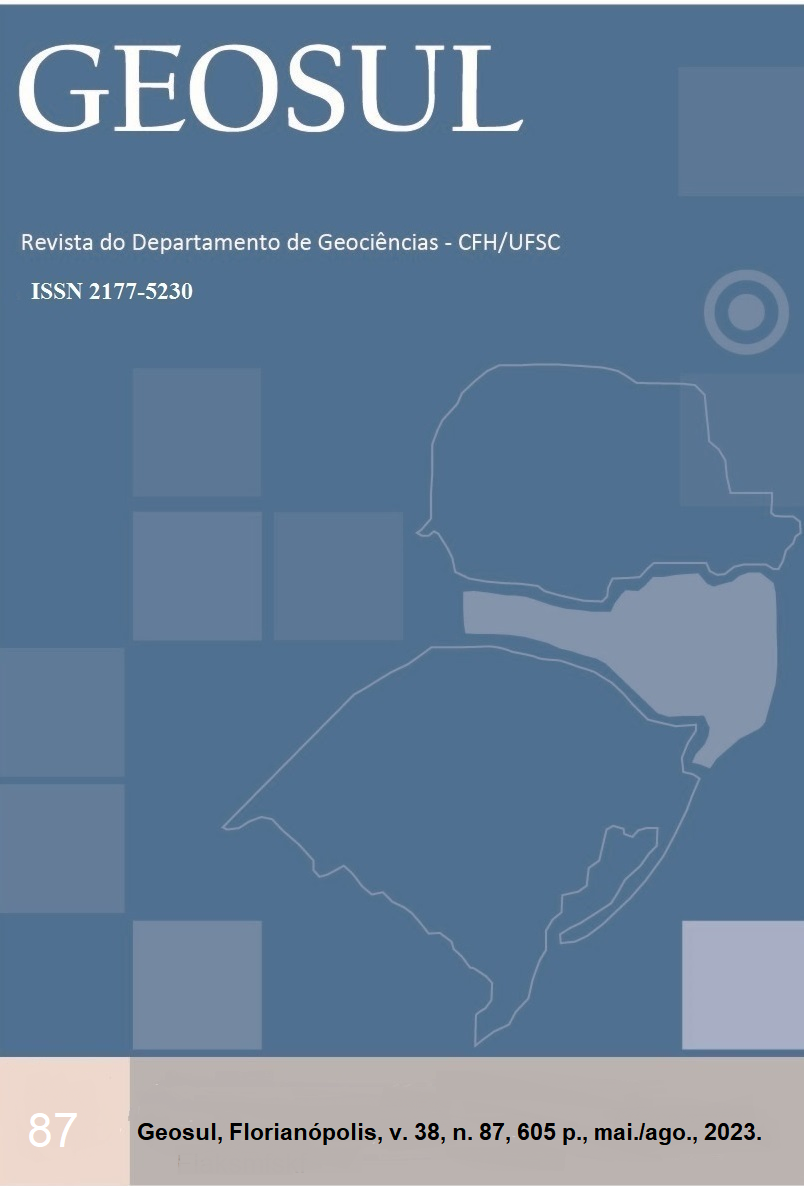Urban system cartography of brazilian mid-sized cities
DOI:
https://doi.org/10.5007/2177-5230.2023.e91993Keywords:
Areas of Influence of Cities, Mid-Sized Cities, Urban Network, Spatial Analysis, Geographic CartographyAbstract
This article carry out an analysis of the spatial distribution of the areas of influence of 230 urban centers considered as mid-sized cities in the Brazilian territory, based on the hierarchy of the urban network presented in studies by the Brazilian Institute of Geography and Statistics - IBGE (2015; 2020). The research methodology is based on assumptions and procedures articulated in three structural bases: division of the national territory into three geoeconomic regions (Amazon, Northeast and Center-South); classification of mid-sized cities, from criteria related to population amount, level of regional centrality and situation related to the context of geoeconomic regions, and; identification, mapping and characterization of the areas of influence in each of the selected cities. The research results provide contributions to the knowledge of mid-sized cities system in Brazil, and may support the elaboration of territorial development policies.
References
CORRÊA, R. L. Trajetórias geográficas. Rio de Janeiro: Bertrand Brasil, 1997.
CORRÊA, R. L. Estudos sobre a rede urbana. Rio de Janeiro: Bertrand Brasil, 2006.
CORRÊA, R. L. Diferenciação sócio-espacial, escala e práticas espaciais. Cidades, Presidente Prudente, v. 4, n. 6, p. 62-72, 2007.
CRAMPTON, J. W. Mapping: a critical introduction to Cartography and GIS. Oxford: Blackwell, 2010.
EGLER, C. A. G. Apontamentos sobre rede urbana e políticas públicas no Brasil. In: MATOS, R.; SOARES, W. desigualdades, redes e espacialidades emergentes no Brasil. Belo Horizonte: C/ Arte, 2010. p. 91-114.
EMPLASA – EMPRESA PAULISTA DE PLANEJAMENTO METROPOLITANO; FUNDAÇÃO SEADE. Rede urbana e regionalização do Estado de São Paulo. São Paulo: EMPLASA, 2011.
GEIGER, P. P. Organização regional do Brasil. Revista Geográfica, Rio de Janeiro, t. 33, n. 61. p. 25-57, 1964.
GIRARDI, G. Cartografia geográfica: reflexões e contribuições. Boletim Paulista de Geografia, São Paulo, n. 87, p. 45-65, dez. 2007.
IBGE – INSTITUTO BRASILEIRO DE GEOGRAFIA E ESTATÍSTICA. Arranjos Populacionais e Concentrações Urbanas do Brasil. Rio de Janeiro: IBGE, 2015.
IBGE - INSTITUTO BRASILEIRO DE GEOGRAFIA E ESTATÍSTICA. Estimativas populacionais para os municípios brasileiros em 01.07.2020. Disponível em: https://ftp.ibge.gov.br/Estimativas_de_Populacao/Estimativas_2020/estimativa_dou_2020.pdf. Acesso em: 5 out. 2020a.
IBGE – INSTITUTO BRASILEIRO DE GEOGRAFIA E ESTATÍSTICA. Regiões de Influência das Cidades: 2018. Rio de Janeiro: IBGE, 2020b.
IPEA – INSTITUTO DE PESQUISA ECONÔMICA APLICADA; IBGE – INSTITUTO BRASILEIRO DE GEOGRAFIA E ESTATÍSTICA; UNICAMP – UNIVERSIDADE ESTADUAL DE CAMPINAS. Caracterização e tendências da rede urbana do Brasil: estudos básicos para caracterização da rede urbana. Brasília: IPEA, 2001. v. 1.
LAMBERT, N.; ZANIN, C. Manuel de Cartographie: principes, méthodes, applications. Paris: Armand Colin, 2016.
MATIAS, L. F. Por uma cartografia geográfica: uma análise na representação gráfica na Geografia. Dissertação (Mestrado em Geografia Humana), FFLCH/USP, 1996.
MIRANDA, E. E.; MAGALHÃES, L. A.; CARVALHO, C. A. Proposta de delimitação territorial do MATOPIBA. Campinas: Embrapa, 2014. (Nota Técnica 1).
MOTTA, D. M.; EGLER, C. A. G.; RIBEIRO, M. B; ARAÚJO SOBRINHO, F. L.; NASCIMENTO, E.; ARRUDA, R. A.; SACCARO JÚNIOR, N. L.; PÊGO, B. Projeto competitividade e governança das cidades médias do Brasil: referencial conceitual e metodológico. Relatório 1. [Brasília]: IPEA, 2022a. (Relatório Institucional)
MOTTA, D. M.; EGLER, C. A. G.; RIBEIRO, M. B; ARAÚJO SOBRINHO, F. L.; NASCIMENTO, E.; ARRUDA, R. A.; SACCARO JÚNIOR, N. L.; PÊGO, B. Projeto competitividade e governança das cidades médias do Brasil: sistema urbano, centralidade e competitividade das cidades médias. Relatório 2. [Brasília]: IPEA, 2022b. (Relatório Institucional)
OECD – ORGANISATION FOR ECONOMIC COOPERATION AND DEVELOPMENT. Redefining “urban”: a new way to measure metropolitan areas. Paris: OECD, 2012.
SALICHTCHEV, K. A. Cartographic communication: its place in the theory of science. The Canadian Cartographer, Toronto, University of Toronto Press, n. 15, v. 2, p. 93-99, 1978.
SANTOS, M. A natureza do espaço. São Paulo: Edusp, 2002.
SANTOS, M.; SILVEIRA, M. L. O Brasil: território e sociedade no início do século XXI. 13. ed. Rio de Janeiro: Record, 2010.
SPOSITO, M. E. B. As cidades médias e os contextos econômicos contemporâneos. In: SPOSITO, M. E. B. (Org.). Urbanização e cidades: perspectivas geográficas. Presidente Prudente: Unesp, FCT, 2001. p. 609-643.
STEINBERGER, M.; BRUNA, G. C. Cidades médias: elos do urbano-regional e do público-privado. In: ANDRADE, T. A.; SERRA, R. V. (Eds.). Cidades médias brasileiras. Rio de Janeiro: IPEA, 2001. p. 35-77.
ZEILER, M. Modeling our World. Redlands, EUA: ESRI, 2000.
Downloads
Published
Issue
Section
License

Este trabalho está licenciado com uma Licença Creative Commons - Atribuição 4.0 Internacional.





